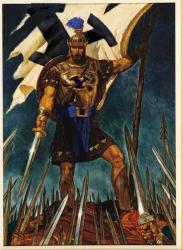-
•
•
23 responses
While I don’t really have a television, there are a couple of shows that I regularlly watch through Netflix or hulu.com. Among them is The Office. I actually think that some of C.S. Lewis’s thoughts on the nature of love help to make sense of Michael Scott. Read More
-
•
•
… and if you had lived in the Mormon Corridor or somewhere else with a fully organized Primary, you would have become a Trail-Builder when you turned 10 in 1925, and you would have received one of the new “First Year Books” to track your progress during the year as your learned to do some really cool boy stuff. Your handbook was decorated with the pine tree, your class emblem, and you learned how this tree represented the kind of boy you were learning to be: Read More
-
•
•
2 responses
Continuing part 1 , part 2, and part 3. Nephi’s response to his brothers directly attacks their understanding of Moses’s significance. Read More
-
•
•
49 responses
Seven Storey Mountain is Thomas Merton’s autobiographical account of his increasing restlessness with a worldly life. He converts to Catholicism and eventually enters one of the most strict (the strictest?) Catholic orders: a Trappist monastery. What has fascinated me Read More
-
•
•
Utah’s 19th century silk industry was one of those projects encouraged by Brigham Young to stimulate home production and reduce Mormon dependence on a hostile world. Period literature is heavy on sermons advocating sericulture, treatises on raising worms and the mulberry trees they fed on, and praise for the quantities and artistry of finished articles. What I’ve never seen before is the memoir of a child who assisted in the enterprise. Read More
-
•
•
David G. at Juvenile Instructor (the blog, not the periodical) has just posted Mormonism’s Unbroken Past: Transcending the 1890 Rupture, noting that 1890 is as historically significant to the Mormons as that year is to the wider history of the West: For us, the 1890 Manifesto marked as great a shift in outlook, traditional Mormon historical thinking goes, as the 1890 “closing of the frontier,” declared in 1893 by Western historian Frederick Jackson Turner, signaled in the development of all that was distinctively American. Read More
-
•
•
13 responses
A comprehensive bibliography? A portfolio of LDS-owned companies? No, it’s a measure of food-storage activity by preparedness-minded Mormons, as revealed in a feature at the St. Louis Post-Dispatch, “The Mormon Index is a rising sign of troubled economy.” Read More
-
•
•
It’s not too late to send in a proposal for this year’s Mormon Scholars in the Humanities conference, May 8-9 at Aspen Grove and BYU, Provo, UT. Speaker John Caputo and individualized scholarly mentoring opportunities are special highlights this year. Read More
-
•
•
Friedrich Schulzke Read More
-
•
•
19 responses
We are delighted to announce that Ardis Parshall’s posts will be returning to T&S. Read More
-
•
•
42 responses
Thanks for all the comments on site design. We’re still making use of that feedback. Here is a two sidebar option that gives a great deal of info up top, but then quickly drops off to just let you read in peace as you get farther down the page. Take it for a spin. Read More
-
•
•
8 responses
Continuing part 1 and part 2. Laman and Lemuel offer up their gloss on the story of Moses in verse 22 and in so doing model a particular type of scriptural and legal interpretation. They say: And we know that the people who were in the land of Jerusalem were a righteous people; for they kept the statutes and judgments of the Lord, and all his commandments, according to the law of Moses; wherefore, we know that they are a righteous people; and our father hath judged them, and hath led us away because we would hearken unto his words;… Read More
-
•
•
59 responses
We’ve spiffed up our design a little bit. Have a look around and let us know what you like and what you don’t. We may not do anything about your comments; but then again, we might, and the venting should be good for you regardless. Read More
-
•
•
21 responses
I am a total NPR dork. I would LOVE to have Carl Kasell’s voice on my answering machine; when I was in middle school, I felt betrayed when I learned that Lake Woebegone wasn’t a real place; and I admit that I joined Ira Flatow’s Science Friday Facebook group (“for those who love Science Friday. Or Ira Flatow.”). In fact, all my scientific knowledge pretty much comes from either Science Friday or the SciFi channel. That’s essentially my disclaimer before I jump into a discussion of quantum mechanics: my knowledge of quantum entanglement is limited to how much Ira Flatow… Read More
-
•
•
2 responses
Laman and Lemuel make their appearance in chapter 17 in verse 17, where they say: Read More
-
•
•
71 responses
“We need to exercise our prayers and help [President Obama] accomplish the great objectives that he has set.” Discuss. Read More
-
•
•
20 responses
-
•
•
27 responses
This final of three posts, covers Times and Seasons reader Last Lemming’s suggestions for Mormon of the Year for the years 1990 through 2007. We already posted on Monday his picks for 1950 through 1969 and on Wednesday 1970 through 1989. I suspect as these posts get into more familiar and more recent territory, more of you will have comments and suggestions about who Last Lemming suggested and who should have been suggested instead. Read More
-
•
•
9 responses
Our ward has been exploring the idea of Unity in our sacrament meeting talks this month, and I’ve heard the same attribution to Elder Dallin H. Oaks several times. It apparently comes from a “News of the Church” article in June 2007 which discusses the growing diversity in the Church. According to the article, Elder Oaks “said that the growing diversity among the members is simply a condition, not a Church goal. The real goal is unity, not diversity.” Perhaps’ I’m not listening closely enough, but the discussions of this idea seem to have missed the balance of what was… Read More
-
•
•
43 responses
This post is Janet’s fault. Read More
-
•
•
16 responses
Over the holidays I discovered the poetry of Carol Lynn Pearson, which I have been enjoying. At times she spills over into the trite or saccharine, but on the whole I like it. There is nothing agonistic about it, which is the reason that Terryl Givens doesn’t much care for it. I think that he’s right, however, that by taking Emily Dickinson (another poetess I’ve recently started reading) as her model, the conciseness of her style frequently rescues her from smugness. At its best, there is an engaging naivete in her verse, a kind of simple purity that skates at… Read More
-
•
•
3 responses
Owing to the fact that I am a moron, Jim F.’s excellent Doctrine and Covenants Sunday School lessons are inordinately hard to retrieve. Here are links to a few of them, and we’ll have the rest of them easy to get to by next week. Doctrine and Covenants Lesson 2 Doctrine and Covenants Lesson 3 Doctrine and Covenants Lesson 4 Doctrine and Covenants Lesson 5 Jim no longer posts at T&S, but he still reads here on occasion, so if you have nice things to say or helpful comments about any of these lessons, please feel free to post them… Read More
-
•
•
51 responses

After nearly 40 years in the wilderness, HUAC is back in style! Read More
-
•
•
One response
Mormon Studies took another step forward this week with the announcement of two doctoral fellowships in Mormon Studies. Courtesy of the George S. and Delores Doré Eccles Foundation, the two fellowships will be awarded one a year this year and next. With any luck, the fellowships will be repeated in future years, assuming that they successfully lead to dissertations. Read More
-
•
•
3 responses
At Last Lemming’s request, I have postponed the last of the three “Who Should Be Mormon of the Year” segments until Tuesday morning. That segment covers 1990 to 2007. Last Lemming will be out-of-town during the weekend, and wants to be sure he is available to comment and react to others’ comments on the post. Read More
-
•
•
11 responses
This is the first of a series of posts in which I will be offering some commentary on 1 Nephi 17. Why that particular chapter you ask? The answer is that I believe that chapter 17 is setting forth a method of scriptural interpretation that proved to be very important both for the Book of Mormon and for Mormonism generally. Furthermore, what I find fascinating about the story is that ultimately it is about the legal interpretation of scripture. Read More
-
•
•
27 responses
There is a certain category of life-experiences that I refer to as “Twenty-Mark Note” stories. The name for these experiences comes from a talk by the same name, given by President Packer at BYU-Idaho in 2002 (excerpted below). I suspect that once you read President Packer’s remarks, you’ll immediately recall your own Twenty-Mark experiences: Read More
-
•
•
16 responses

NPR recently did a story about a group of reporters’ visit to the newly constructed Draper Temple. The Draper Temple, by all appearances, is characteristically beautiful. I am as intrigued by the process of building a new temple, as I am by the end product itself. Some of the most marvelous stories from church history involve sacrifices that the Saints – ancient and modern – have made in order to build a House consecrated to the Lord. Unfortunately, the sacrifices and challenges that go into constructing a temple are often not immediately apparent, particularly to those of us living in North… Read More
